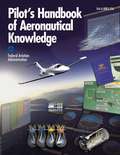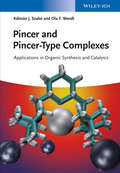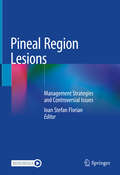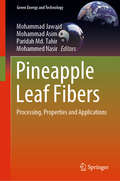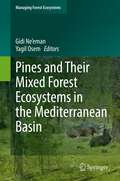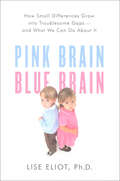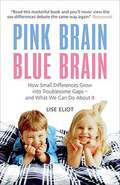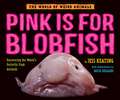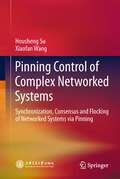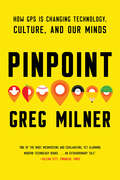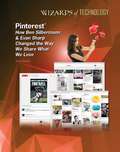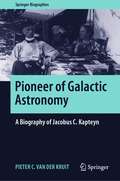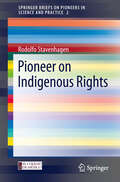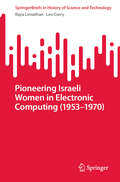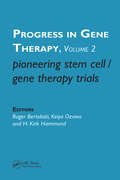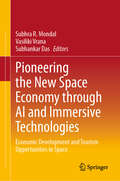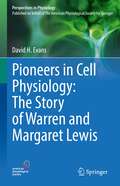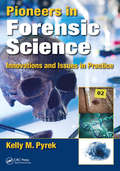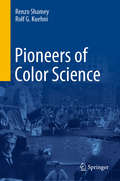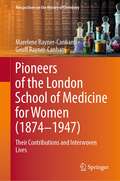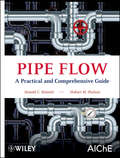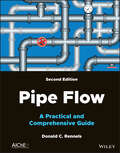- Table View
- List View
Pilot's Handbook of Aeronautical Knowledge: Faa-h-8083-25, December 2003 (FAA Handbooks Ser.)
by Federal Aviation AdministrationPilot's Handbook of Aeronautical Knowledge, created by the Federal Aviation Administration, is the official reference manual for pilots at all levels. An indispensable and invaluable encyclopedia, it deals with all aspects of aeronautical information.Each chapter focuses on a different area that pilots are tested on in flight school and must need to know before they fly a plane on of their own. These topics include:aircraft structureprinciples of aerodynamicsflight controlsaircraft systemsflight instrumentsand moreFlight manuals and documentation are also covered, as is specialized information on such matters as weight and balance, aircraft performance, weather, navigation, airport operations, aeromedical factors, and decision-making while flying. An updated appendix, detailed index, and full glossary make this book easy to navigate and useful in quick reference situations.
Pincer and Pincer-Type Complexes
by Ola F. Wendt Kálmán J. SzabóThis new book on this hot topic summarizes the key achievements for the synthesis and catalytic applications of pincer and pincer-type complexes, providing readers with the latest research highlights. The editors have assembled an international team of leaders in the field, and their contributions focus on the application of various pincer complexes in modern organic synthesis and catalysis, such as C-C and C-X bond forming reactions, C-H bond functionalization, and the activation of small molecules, as well as asymmetric catalysis. A must-have for every synthetic chemist in both academia and industry intending to develop new catalysts and improved synthetic protocols.
Pineal Region Lesions: Management Strategies and Controversial Issues
by Ioan Stefan FlorianNeurosurgical lesions of the pineal region are extremely rare, accounting for roughly 1% of the total number of neurosurgical expansive lesions in modern practice. This book offers an up-to-date review of the relevant literature, combined with the personal perspectives of some highly experienced figures in the field. The book is divided into two main parts, the first of which offers an overview of the pineal region from an anatomic, pathologic, imaging and therapeutic perspective. Special attention is given to surgical approaches to pineal region lesions. Microsurgical techniques are presented, together with detailed indications regarding specific locations of these lesions, specific complications, and controversial aspects concerning some of the approaches. A dedicated chapter addresses endoscopic techniques, their indications and limitations. Adjuvant therapies are also discussed, along with their particular indications and debated aspects.In turn, the chapters in the second part cover specific lesions such as pineal region tumors, vascular lesions, and cystic and cyst-like lesions. Regarding pineal region tumors, the most frequent pathologies are presented in the most comprehensive and practical manner possible, with special attention to the appropriate therapeutic management for each type. Further, there is a dedicated chapter on pineal region cysts. Given its depth of content, the book will allow neurosurgeons and specialists to greatly expand their understanding of pineal region lesions in daily clinical practice.
Pineapple Leaf Fibers: Processing, Properties and Applications (Green Energy and Technology)
by Mohammad Jawaid Mohammad Asim Paridah Md. Tahir Mohammed NasirThis book presents recent research on natural fibers extracted from pineapple leaves. Covering several extraction processes, properties of pineapple leaf fibers and comparisons with other natural fibers, and their applications, it provides up-to-date information on the subject of natural fibers from prominent researchers in academia and industry as well as government/private research laboratories across the world. The book is a comprehensive reference resource for university and college faculties, professionals, postdoctoral research fellows, undergraduate/graduate students, researchers and scientists working in the areas of non-forest product utilization, natural fibers, and biomass materials.
Pines and Their Mixed Forest Ecosystems in the Mediterranean Basin (Managing Forest Ecosystems #38)
by Gidi Ne’eman Yagil OsemAlmost 20 years after the first MEDPINE book "Ecology, biogeography and management of Pinus halepensis and P. brutia forest ecosystems in the Mediterranean basin "(Ne'eman and Trabaud, 2000) was published, this new book presents up-to-date and state of the art information, covering a wide range of topics concerning Mediterranean pine trees growing in native and planted forests, their ecosystems and management. This will be an essential source of scientific information for learning, exploring planning and managing mediterranean pine and mixed forests. We focus on: genetics, adaptation, distribution and evolution; ecophysiology and drought resistance; pine and mixed forest ecosystems; forest dynamics biodiversity and biotic interactions; fire ecology; ecosystem services and policy; afforestation and management; all under the effect of global climate change. While forests are studied mainly in temperate and tropical zones, in the light of current climate change, focusing on Mediterranean forests growing in semi-humid to semi-arid zones is more important than ever. This book will include mostly review chapters (and two outstanding case studies) contributed by leading scientists, foresters and managers, and will serve as a scientific textbook for students of biology, agriculture and forestry, researchers of ecology forestry and related fields, forest managers, policy and decision makers.
Pink Brain, Blue Brain: How Small Differences Grow Into Troublesome Gaps—And What We Can Do About It
by Lise EliotA scientific study of the differences between boys & girls that tackles damaging gender stereotypes and offers practical guidance for parents & educators.In the past decade, we’ve heard a lot about the innate differences between males and females, so we’ve come to accept that boys can’t focus in the classroom and girls are obsessed with relationships. In Pink Brain, Blue Brain, neuroscientist Lise Eliot turns that thinking on its head. Presenting the latest science from birth to puberty, Eliot zeroes in on the precise differences between boys and girls, reining in harmful stereotypes. She argues convincingly that infant brains are so malleable that what begin as small differences at birth become amplified over time, as parents and teachers—and the culture at large—unwittingly reinforce gender stereotypes.The good news is that by appreciating how sex differences emerge—rather than assuming them to be fixed biological facts—we can help all children reach their fullest potential. Eliot offers teachers and parents concrete ways to help close the troubling gaps between boys and girls ultimately end the gender wars that currently divide us.
Pink Brain, Blue Brain: How Small Differences Grow into Troublesome Gaps - And What We Can Do About It
by Lise EliotTurning conventional thinking about gender differences on its head, Lise Eliot issues a call to close the troubling gaps between boys and girls and help all children reach their fullest potential. Drawing on years of exhaustive research and her own work in the field of neuroplasticity, Eliot argues that infant brains are so malleable that small differences at birth become amplified over time as parents, teachers, and the culture at large unwittingly reinforce gender stereotypes. Indicating points of intervention where social pressures can be minimised, she offers concrete solutions for helping everyone grow into wellrounded individuals.
Pink Is For Blobfish: Discovering the World's Perfectly Pink Animals (The World of Weird Animals)
by Jess KeatingPinkalicious meets National Geographic in this nonfiction picture book introducing the weirdest, wildest, pinkest critters in the animal kingdom! Some people think pink is a pretty color. A fluffy, sparkly, princess-y color. But it's so much more. Sure, pink is the color of princesses and bubblegum, but it's also the color of monster slugs and poisonous insects. Not to mention ultra-intelligent dolphins, naked mole rats and bizarre, bloated blobfish. Isn't it about time to rethink pink? Slip on your rose-colored glasses and take a walk on the wild side with zoologist Jess Keating, author of How to Outrun a Crocodile When Your Shoes Are Untied, and cartoonist David DeGrand.A New York Public Library Best Book for Kids, 2016"The 2016 Ambassador to Young People&’s Science and Nature books is unquestionably the blobfish." —Shelftalker"Readers will never look at pink the same way." —Publishers Weekly
Pinktoes and Other Tarantulas (World Book's Animals of the World)
by Lisa KlobucharThe book covers the care of tarantulas, as well as their history, other kinds in the wild and how to care for a pet tarantula.
Pinning Control of Complex Networked Systems
by Housheng Su Xiaofan WangSynchronization, consensus and flocking are ubiquitous requirements in networked systems. Pinning Control of Complex Networked Systems investigates these requirements by using the pinning control strategy, which aims to control the whole dynamical network with huge numbers of nodes by imposing controllers for only a fraction of the nodes. As the direct control of every node in a dynamical network with huge numbers of nodes might be impossible or unnecessary, it's then very important to use the pinning control strategy for the synchronization of complex dynamical networks. The research on pinning control strategy in consensus and flocking of multi-agent systems can not only help us to better understand the mechanisms of natural collective phenomena, but also benefit applications in mobile sensor/robot networks. This book offers a valuable resource for researchers and engineers working in the fields of control theory and control engineering. Housheng Su is an Associate Professor at the Department of Control Science and Engineering, Huazhong University of Science and Technology, China; Xiaofan Wang is a Professor at the Department of Automation, Shanghai Jiao Tong University, China.
Pinocchio Rex and Other Tyrannosaurs (Let's-Read-and-Find-Out Science 2)
by Melissa Stewart Steve BrusatteRead and find out about tyrannosaurs beyond T. Rex in this colorfully illustrated nonfiction picture book.Everyone knows that Tyrannosaurus rex is the huge dinosaur with sharp claws and tiny arms. But in this appealing level 2 picture book from acclaimed science writer Melissa Stewart, you’ll learn that T. rex is not the only tyrannosaur that existed in prehistoric times. This book is the perfect overview of the exciting new discoveries in the land of tyrannosaurs. Read and find out how tyrannosaurs evolved—from the tiny Dilong to the enormous T. rex. The book also includes an infographic, activity, and glossary, as well as “Dr. Steve Says” sidebars that give readers insight into what it felt like for Dr. Steve to be involved with the discovery of P. Rex!In the last fifteen years, scientists have found many tyrannosaurs, including one with a really long pointy nose. The New York Times bestselling coauthor of this book, Dr. Steve Brusatte, went to China in order to help ID the dinosaur that he would give the nickname Pinocchio Rex.This is a clear and appealing science book for early elementary age kids, both at home and in the classroom. It's a Level 2 Let's-Read-and-Find-Out, which means the book explores more challenging concepts for children in the primary grades. The 100+ titles in this leading nonfiction series are:hands-on and visualacclaimed and trustedgreat for classroomsTop 10 reasons to love LRFOs:Entertain and educate at the same timeHave appealing, child-centered topicsDevelopmentally appropriate for emerging readersFocused; answering questions instead of using survey approachEmploy engaging picture book quality illustrationsUse simple charts and graphics to improve visual literacy skillsFeature hands-on activities to engage young scientistsMeet national science education standardsWritten/illustrated by award-winning authors/illustrators & vetted by an expert in the fieldOver 130 titles in print, meeting a wide range of kids' scientific interestsBooks in this series support the Common Core Learning Standards, Next Generation Science Standards, and the Science, Technology, Engineering, and Math (STEM) standards. Let's-Read-and-Find-Out is the winner of the American Association for the Advancement of Science/Subaru Science Books & Films Prize for Outstanding Science Series.
Pinpoint: How Gps Is Changing Technology, Culture, And Our Minds
by Greg MilnerPinpoint tells the story of GPS, a scientific marvel that enables almost all modern technology--but is changing us in profound ways. Over the last fifty years, humanity has developed an extraordinary shared utility: the Global Positioning System. Even as it guides us across town, GPS helps land planes, route mobile calls, anticipate earthquakes, predict weather, locate oil deposits, measure neutrinos, grow our food, and regulate global finance. It is as ubiquitous and essential as another Cold War technology, the Internet. In Pinpoint, Greg Milner takes us on a fascinating tour of a hidden system that touches almost every aspect of our modern life. While GPS has brought us breathtakingly accurate information about our planetary environment and physical space, it has also created new forms of human behavior. We have let it saturate the world's systems so completely and so quickly that we are just beginning to confront the possible consequences. A single GPS timing flaw, whether accidental or malicious, could bring down the electrical grid, hijack drones, or halt the world financial system. The use, and potential misuse, of GPS data by government and corporations raise disturbing questions about ethics and privacy. GPS may be altering the nature of human cognition--possibly even rearranging the gray matter in our heads. Pinpoint tells the sweeping story of GPS from its conceptual origins as a bomb guidance system to its presence in almost everything we do. Milner examines the different ways humans have understood physical space, delves into the neuroscience of cognitive maps, and questions GPS's double-edged effect on our culture. A fascinating and original story of the scientific urge toward precision, Pinpoint offers startling insight into how humans understand their place in the world.
Pinterest®: How Ben Silbermann & Evan Sharp Changed the Way We Share What We Love
by Rosa WatersIn the last few years, Pinterest has become one of the world's most popular social networking sites, allowing users to share the things they love with others by "pinning" pictures to an interactive online bulletin board. You may have heard of Pinterest, you may use it yourself--but do you know the story behind the success? Discover the story of how two friends, Ben Silbermann and Evan Sharp, changed social networking with Pinterest. Find out what it took for the two young men to start their own company--and learn what they have planned for the future of Pinterest.
Pioneer of Galactic Astronomy: A Biography of Jacobus C. Kapteyn (Springer Biographies)
by Pieter C. van der KruitThis non-technical biography of Jacobus Cornelius Kapteyn (1851-1922) presents to the general reader the scientific life of the astronomer who pioneered the studies of the structure of the Milky Way Galaxy. In telling Kapteyn’s story the author weaves in astronomy basics and uses modern astronomical images to show the developments of astronomical research from Kapteyn’s times to the present. In particular the study of the distribution of stars in space has now culminated with spectacular new insights coming from the astrometric satellite GAIA, which is receiving much public attention today.The biography shows how Kapteyn’s ideas influenced prominent astronomers worldwide. He is prominent as designer of the Kapteyn Universe, the alternative to the large system found by Harlow Shapley. He is the discoverer of Kapteyn’s Star, still the second fastest moving star in the sky, which is now one of the nearest stars with a planet in the habitable zone. This fascinating hybrid of astronomy history and popular astronomy tells the story of the astronomy professor without an observatory who founded the first astronomical laboratory specializing in measuring photographic plates exposed elsewhere. Kapteyn took astronomy out of cataloguing stars to measuring distances and velocities in order to study their spatial distribution, systematic motions (Kapteyn’s Star Streams) and the equilibrium between their gravity and motions. His legacy includes, in addition to the first application of Galactic structure and dynamics, Jan Hendrik Oort, the famous astronomer from Leiden, who as a student was so impressed by Kapteyn’s lectures that he decided to become an astronomer.
Pioneer on Indigenous Rights
by Rodolfo StavenhagenOn the occasion of the 80th birthday of Rodolfo Stavenhagen, a distinguished Mexican sociologist and professor emeritus of El Colegio de Mexico, Úrsula Oswald Spring (UNAM/CRIM, Mexico) introduces him as a Pioneer on Indigenous Rights due to his research on human rights issues, especially when he served as United Nations Special Rapporteur on the rights of indigenous peoples. First, in a retrospective Stavenhagen reviews his scientific and political work for the rights of indigenous peoples. Seven of his classic texts address Seven Fallacies about Latin America (1965); Decolonializing Applied Social Sciences (1971); Ethnodevelopment: A Neglected Dimension in Development Thinking (1986); Human Rights and Wrongs: A Place for Anthropologists? (1998); Indigenous Peoples and the State in Latin America: An Ongoing Debate (2000); Building Intercultural Citizenship through Education: A Human Rights Approach (2006); and Making the Declaration Work (2006). This volume discusses the emergence of indigenous peoples as new social and political actors at the national level in numerous countries, as well as on the international scene. This book introduces a trilogy of Briefs on Rodolfo Stavenhagen published in the same series Pioneers in Science and Practice.
Pioneering Israeli Women in Electronic Computing (SpringerBriefs in History of Science and Technology)
by Leo Corry Raya LeviathanThis book offers a journey into the history of pioneering Israeli women in electronic computing and explores the impact these women had on the annals of Israeli computing history. With the primary setting being the Weizmann Institute of Science, where the genesis of computing in Israel took place, their stories come to life through the lens of personal narratives, and their personal stories provide a unique window into their experiences, challenges, and triumphs. It delves into a compelling narrative of women who defied societal norms and forged their path in a male-dominated field. Their accounts captivate individuals who are passionate about advocating for gender equality and empowerment, as well as those with an interest in the history of computing and the development of information technology in Israel.
Pioneering Stem Cell/Gene Therapy Trials
by Roger Bertolotti Keiyo Ozawa H. Kirk HammondThe first unequivocal success for Gene Therapy was reported in April 2000 for X-SCID patients. Pioneering stem cell/gene therapy clinical trials are the focus of this book. Therapy successes such as the X-SCID trial and improved ADA-SCID ones are presented together with pioneering angio/vasculogenic clinical trials mediated either by transient gene therapy or emerging autologous stem cell transplantation. Highlights also include 1) promises of the breakthrough combination of stem cell- and transient gene-therapy, 2) gene therapy trials for neurodegenerative disease on non-human primates where long-term gene therapy might involve brain stem cells, and 3) the first clinical trial with non-invasive monitoring of therapeutic gene expression as a prospective conclusion.
Pioneering the New Space Economy through AI and Immersive Technologies: Economic Development and Tourism Opportunities in Space
by Subhankar Das Subhra R. Mondal Vasiliki VranaThis book provides a comprehensive, forward-looking examination of how artificial intelligence, immersive technologies, and anthropomorphized robots shape the future of space exploration and commercialization. Space tourism is on the brink of a revolutionary transformation driven by technological advancements and a growing private sector involvement. Bringing together experts from diverse fields, including aerospace engineering, computer science, economics, law, and psychology, the book offers a comprehensive, multidisciplinary perspective on the challenges and opportunities in this exciting new frontier. An essential resource for academics, industry professionals, policymakers, and enthusiasts interested in the intersection of space exploration, tourism, and advanced technologies, the book aims to inspire and inform the next generation of space entrepreneurs, researchers, and explorers by providing a comprehensive overview of current developments and future possibilities in space economy.
Pioneers in Cell Physiology: The Story of Warren and Margaret Lewis (Perspectives in Physiology)
by David H. EvansThis monograph is dedicated to the lives and scientific achievements of the physiology pioneers Warren and Margaret Lewis. Their story spans the first half of the 20th century, from their respective educations through early, independent research to joint research from 1910 to 1955. Among the numerous developments they initiated, were the discovery of pinocytosis, the beginnings of video microscopy and the development of the first mammalian tissue cultures. Their research expanded the theoretical knowledge of cell structure and function. On a more practical level, they advanced many laboratory methods, like the first recipes for culture media. The text is beautifully enriched with personal anecdotes about their lives. This is the story of two scientific pioneers in the context of early 20th century biology and physiology. It is an inspiration for senior and aspiring researchers.
Pioneers in Forensic Science: Innovations and Issues in Practice
by Kelly M. PyrekThis book highlights the contributions of leading forensic science practitioners, iconic figures who have been integral in both establishing current scientific and medicolegal practices and innovative evidence collection, testing, and analysis methods. Such professionals include Henry Lee, Michael Baden, William Bass, Jay Siegel, John Butler, Cyril Wecht, Vincent Di Maio, Marcella Fierro, Barry Fisher, and more. Previously unpublished interviews with these pioneers in the field, expressly undertaken for the purposes this book, examine the last 30 years—past trends that have shaped the field—as well as current and emerging trends that have, and will shape, the future of forensic science.
Pioneers of Color Science
by Rolf G. Kuehni Renzo ShameyThis book provides a comprehensive overview of the historical development of color science, told through the stories of more than 90 of the most prominent figures in the field and their contributions.The text comprises an extensive set of biographical essays about pioneering scientists in the field of color science, describing their most significant achievements and explaining how their findings influenced the general understanding of color. Grouped by historical period, each part is prefaced with a short introduction that sets the essays into context and helps the reader appreciate the background and the importance of the contributions made.Beginning with classical Greece and the works of Plato and Aristotle, the book goes on in the second part to describe the advances made by Islamic scholars such as Ibn al-Haytham between the 10th and 15th centuries. The third part covers contributions from Roger Bacon and Theodoric of Freiberg in the same period. Part four includes discussions on color formation and visual perception for a time period from about the 16th to the 18th centuries encompassing the Age of Enlightenment. This part addresses the works of nineteen pioneers including Descartes, Boyle, Newton, Goethe, Lambert, Purkynje, Runge, Dalton, Young and Chevreul.The final part is the largest section of the book and covers the most recent discoveries and contributions from pioneers born after 1800 and includes over 60 essays. Among the pioneers listed in this chapter are Nobel laureates, vision scientists including Helmholtz, and Hering, and many other notable color pioneers such as Munsell and Land. This part of the book also includes essays on contemporary figures in color science including Adams, Boynton, Crawford, Hardy, MacAdam, Ostwald and Wyszecki and reviews their contributions to this dynamic field.A useful reference for color scientists, science historians, artists and others, Pioneers of Color Science offers a fascinating insight into the development of color science and the nature of scientific advancement.
Pioneers of the London School of Medicine for Women: Their Contributions and Interwoven Lives (Perspectives on the History of Chemistry)
by Geoff Rayner-Canham Marelene Rayner-CanhamThis book presents the pioneering role of the women chemists at the London School of Medicine for Women (LSMW). The account is placed within the framework of the long-forgotten background to the founding of this unique Institution, and the individuals whose lives came together to make it happen: Sophia Jex-Blake; Elizabeth Garrett Anderson; Edith Pechey; and Isabel Thorne. The London School of Medicine for Women (LSMW) was the first School in Britain to enable women to gain medical qualifications. Though its pioneering medical role is beginning to be recognized, the Chemistry Department at the School has been totally overlooked. All first-year students at the LSMW had to spend a significant portion of their time taking theoretical and practical chemistry, taught by dedicated women chemistry instructors. In this book, particular attention is given to each of these exceptionally-talented women chemists who found a haven at, and devoted their lives to, the LSMW. This book also covers the enthusiasm of the women medical students which becomes evident through the chemistry prose and poetry which they wrote. This book will appeal to a wide readership interested in the early role of women in science, and it is particularly relevant to those interested in the lives and contributions of pioneering women chemists.
Pipe Dreams: The Urgent Global Quest to Transform the Toilet
by Chelsea WaldFrom an award-winning science journalist, a lively, informative, and humorous deep dive into the future of the toilet—from creative uses for harvested &“biosolids,&” to the bold engineers dedicated to bringing safe sanitation to the billions of people worldwide living without—for fans of popular science bestsellers by Mary Roach. Most of us do not give much thought to the centerpiece of our bathrooms, but the toilet is an unexpected paradox. On the one hand, it is a modern miracle: a ubiquitous fixture in a vast sanitation system that has helped add decades to human lifespan by reducing disease. On the other hand, the toilet is also a tragic failure: less than half of the world&’s population can access a toilet that safely manages bodily waste, including many right here in the United States. And it is inefficient, squandering clean water as well as the nutrients and energy contained in the waste we flush away. While we see radical technological change in almost every other aspect of our lives, we remain stuck in a sanitation status quo—in part because the topic of toilets is taboo. Fortunately, there&’s hope—and Pipe Dreams daringly profiles the growing army of scientists, engineers, philanthropists, entrepreneurs, and activists worldwide who are overcoming their aversions and focusing their formidable skills on making toilets accessible and healthier for all. This potential revolution in sanitation has many benefits, including reducing inequalities, mitigating climate change and water scarcity, improving agriculture, and optimizing health. Author Chelsea Wald takes us on a wild world tour from a compost toilet project in Haiti, to a plant in the Netherlands that harvests used toilet paper from sewage, and shows us a bot that hangs out in manholes to estimate opioid use in a city, among many other fascinating developments. Much more than a glorified trash can, the toilet, Wald maintains, holds the power to help solve many of the world&’s problems, if only we can harness it.
Pipe Flow
by Donald C. Rennels Hobart M. HudsonPipe Flow provides the information required to design and analyze the piping systems needed to support a broad range of industrial operations, distribution systems, and power plants. Throughout the book, the authors demonstrate how to accurately predict and manage pressure loss while working with a variety of piping systems and piping components.The book draws together and reviews the growing body of experimental and theoretical research, including important loss coefficient data for a wide selection of piping components. Experimental test data and published formulas are examined, integrated and organized into broadly applicable equations. The results are also presented in straightforward tables and diagrams.Sample problems and their solution are provided throughout the book, demonstrating how core concepts are applied in practice. In addition, references and further reading sections enable the readers to explore all the topics in greater depth.With its clear explanations, Pipe Flow is recommended as a textbook for engineering students and as a reference for professional engineers who need to design, operate, and troubleshoot piping systems. The book employs the English gravitational system as well as the International System (or SI).
Pipe Flow: A Practical and Comprehensive Guide
by Donald C. RennelsPipe Flow Provides detailed coverage of hydraulic analysis of piping systems, revised and updated throughout Pipe Flow: A Practical and Comprehensive Guide provides the information required to design and analyze piping systems for distribution systems, power plants, and other industrial operations. Divided into three parts, this authoritative resource describes the methodology for solving pipe flow problems, presents loss coefficient data for a wide range of piping components, and examines pressure drop, cavitation, flow-induced vibration, and other flow phenomena that affect the performance of piping systems. Throughout the book, sample problems and worked solutions illustrate the application of core concepts and techniques. The second edition features revised and expanded information throughout, including an entirely new chapter that presents a mixing section flow model for accurately predicting jet pump performance. This edition includes additional examples, supplemental problems, and a new appendix of the speed of sound in water. With clear explanations, expert guidance, and precise hydraulic computations, this classic reference text remains required reading for anyone working to increase the quality and efficiency of modern piping systems. Discusses the fundamental physical properties of fluids and the nature of fluid flow Demonstrates the accurate prediction and management of pressure loss for a variety of piping components and piping systems Reviews theoretical research on fluid flow in piping and its components Presents important loss coefficient data with straightforward tables, diagrams, and equations Includes full references, further reading sections, and numerous example problems with solution Pipe Flow: A Practical and Comprehensive Guide, Second Edition is an excellent textbook for engineering students, and an invaluable reference for professional engineers engaged in the design, operation, and troubleshooting of piping systems.
